
|
|
| www.wildfirenews.com | Archived 03-31-2003 |
|
BLUE RIBBON PANEL MEMBERS SAY AIRTANKER SYSTEM HAS NOT BEEN FIXEDMARCH 31 -- WASHINGTON, DC: Members of an aerial firefighting safety panel assembled in response to a particularly lethal year said last week their safety recommendations are not being heeded. Forest Service assistant director of aviation Tony Kern and BLM director of aviation Larry Hamilton told the Senate Energy and Natural Resources Committee that fires that don't threaten lives might be allowed to burn this year, according to an AP story in the Casper Star-Tribune. They said they were working on a plan that would not risk the lives of pilots or communities near forests. Last year, 11 airtankers were grounded after six aerial firefighters died in two airtanker crashes and one helicopter crash. The grounding reduced the size of the airtanker fleet from 44 to 33. In response to the accidents, Forest Service Chief Dale Bosworth and BLM Director Kathleen Clark created a five-member Blue Ribbon Fact Finding Panel. The panel held "town hall meetings" in six locations, and produced a report in December. But the panel's co-chairman and former NTSB chairman Jim Hall said that the panel's recommendations have not been heeded. "The present system has not been fixed and it is certainly a situation that needs to be addressed," Hall said. "The safety record of fixed-wing aircraft and helicopters used in wildland fire management is unacceptable," said panel co-chairman and Texas State Forester Jim Hull. "The level of safety for both contractor and governmental aerial firefighting operations is lower than can be financially justified and is less than expected for any responsible employer." Bill Broadwell, director of the Aerial Firefighting Industry Association, said the panel accomplished a lot in a relatively short time, and "they got it right for the most part." "The statement that contractors do not have a financial incentive and are 'not required to ensure their aircraft are safe to fly,'" said Broadwell, "ignores the moral responsibility our operators exercise to ensure the safety of their aircrews." He said operators don't purposely send crews out in unsafe aircraft, but that existing inspection and repair programs are not adequate. He said operators were working with Sandia Laboratories to address that. Sen. Craig Thomas of Wyoming called for standards and questioned the decision to ground some of the airtankers. "It is clear to me that contractors have been operating under inadequate standards," he said. "We cannot continue to have this happen. There were more than seven million acres of land charred last summer because we were dragging our feet in the bureaucratic mud instead of dousing fires. We will face a bigger challenge this summer if our aerial firefighting fleet is reduced." Hawkins & Powers director of operations, Duane Powers, said that even though the company's planes have been inspected and are safe, the federal government has grounded them. Kern countered that the planes had not been "grounded." "You cannot contract with them," answered Thomas, "which effectively grounds them." BLM director of aviation Hamilton said that the planes are often employed in situations where they are not needed. "We call it 'political retardant,'" he said, "when the local congressman calls and says that there is a television camera filming a fire and he wants to know why there is not an airtanker there." Hamilton said the agencies have retired 11 (of 19 total) Baron 58-P leadplanes that had exceeded the 6,000-hour safe life limit. "Within the next couple of weeks," he said, "we plan on releasing a Request for Proposal to replace up to 10 of these planes with newer, more efficient, and safer aircraft through a long-term lease." The full report of the Senate Energy and Natural Resources Committee is online. FATAL HELICOPTER CRASH IN TEXAS SHUTTLE SEARCHMARCH 28 -- BROADDUS, TEXAS: Two people were killed and three others injured yesterday when a U.S. Forest Service helicopter crashed while searching for shuttle materials in east Texas. Texas Forest Service employee Charles Krenek of Lufkin and Pilot J. "Buzz" Mier of Arizona were killed in the crash. The injured were identified as Matt Tschacher, U.S. Forest Service, from South Dakota; Richard Lange, United Space Alliance at Kennedy Space Center of Florida; and Ronnie Dale, NASA Kennedy Space Center of Florida. KOTA-TV reported that Tschacher, stationed with the Hell Canyon Ranger District out of Newcastle, Wyoming, will undergo surgery today to remove a bone chip from his neck. The Bell 407 helicopter was under contract with Papillon Helicopters of Arizona. USA Today reported that seven helicopters were searching in the area yesterday; the crash site was accessible only from muddy, rutted stretches of trail. Investigators from the FAA and NTSB were en route, and News 8 Austin reported that the San Augustine County Sheriff's Office and Texas DPS are assisting in the investigation. The crash occurred east of Lufkin about 4:30 p.m. in rough wooded terrain on the Angelina National Forest. The Washington Times reported that ground crews were told of the accident at camp briefings this morning; there were "moments of silence" observed before the day's work began. The Houston Chronicle reported that William Dickerson of San Augustine said he and his nephew were on a fishing trip and saw the helicopter fly overhead. Dickerson said the helicopter suddenly went silent, then crashed into the trees. "When we heard it, we knew what it had to be," he said. "It was just like the motor went dead." Dickerson said the helicopter landed in a swampy area, with the motor buried in the ground and pieces of the chopper strewn around. He and his nephew helped the three survivors out of the woods and to the side of the road before going to a nearby house to call for help. Shuttle search aircraft operations have been temporarily discontinued. 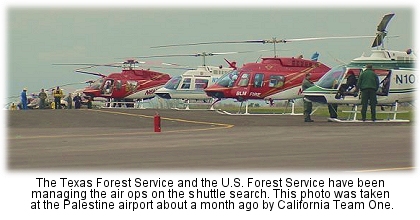 The Texas Forest Service and the U.S. Forest Service have been managing the air crews that fly search grids in coordination with ground crews. Earlier this week they said 36 helicopters were working under contract with the U.S. Forest Service. Ten fixed-wing aircraft fly above the helicopters as spotters and communication links. JURY REACHES VERDICT IN UKIAH TRIALMARCH 28 -- UKIAH, CA: There's good news and bad news on the jury verdict in the trial of defendants Richard Mortensen and Frank Brady, who were charged with second-degree murder (and a number of other charges) for starting a wildfire while manufacturing methamphetamine. In August 2001 two CDF airtanker pilots were killed when their tankers collided over the fire that was ignited by Brady and Mortensen in what was alleged to be a methamphetamine operation near Hopland. The good news is that 7 out of 12 of the counts returned by the jury yesterday afternoon were guilty. The bad news is that the second-degree murder charges against both defendants didn't come through. Brady was found guilty by the jury of arson causing death, but Mortensen was spared that charge by the jury. Brady could face over 14 years in prison just on the charges he was convicted for, and Mortensen is still looking at 8 years or more. The Santa Rosa Press-Democrat reported that the jury convicted Brady of causing the fire, and both defendants were convicted of making methamphetamine. Both men were acquitted of second-degree murder. According to sources in the courtroom yesterday, Brady was found not guilty of charges 1 and 2 (murder) but guilty on charges 3 and 4 (related to manufacturing meth). He was, however, found guilty on the #4 charge of "recklessly causing a fire that caused great bodily injury." The jury decided that Mortensen was not guilty on that charge. Leaving alone for a moment the irony of "great bodily injury" as compared with the deaths of two California fire pilots, that particular guilty charge against Brady is (sortof) good news for the fire community. Linda Jarvis, one of the jurors, said gaps in the evidence presented by the prosecution made it hard to conclude that the fire started inside the trailer where Brady and Mortensen were accused of making meth. She said the rarity of airtanker collisions also was a factor in the decision. The crash that killed Lars Stratte and Larry Groff was the only midair collision in the history of CDF's aviation program. Mortensen was found not guilty, according to local resident Lorie Egerer, on numerous other counts he was charged with, but the jury did find him guilty of meth manufacturing charges and conspiracy. He may face a sentence of 8 years and 8 months, according to Egerer, whose home and business were saved by air attack on the fire and who has followed this trial with more than a bit of interest. Two previous attempts by Mendocino County prosecutors to win murder cases involving separate airtanker crashes failed in the 1970s. Sentencing is scheduled for April 21. JURY STARTS OVER ON UKIAH MURDER TRIALMARCH 27 -- UKIAH, CA: Deliberations in the Brady/Mortensen murder trial began anew on Tuesday with a replacement juror; juror number five was removed Monday after he brought into jury deliberations information he'd obtained outside the courtroom. "The court did find juror number five had committed misconduct," Judge Jeffrey Tauber said. But he added that the information did not appear to be significant, and it had been at least implied during the trial. The Ukiah Daily Journal reported that the information was related to alleged methamphetamine production at a local residence several years before the August 2001 fire at which two fire pilots were killed in a mid-air collision. Defendants Richard Mortensen and Frank Brady were at or near the trailer when the 2001 fire broke out. They're charged with two counts of second-degree murder because they started the fire while allegedly manufacturing methamphetamine. Jurors had reached verdicts on all but one count against one of the defendants last Friday. They were working on breaking the stalemate late Monday when one juror revealed information he'd been told by a co-worker several weeks ago. The judge ruled that the jury must now begin deliberations from scratch, so the new juror (who sat in on the trial but not jury deliberations) can fairly participate. By the time jurors went home Tuesday, they had reached seven of the required 12 verdicts. FIRE RESEARCH LESS THAN 2 PERCENT OF NATIONAL FIRE BUDGETMARCH 27 -- TUCSON, AZ: Scientists and fire managers are examining better ways to fight fires, reduce fuels, and rehab burned areas at meetings this week in Tucson; they're working on a research agenda for those topics and to improve communication between firefighters and academics. "We need science to confirm we're on the right track, doing the right things," said John Szymoniak of the USFS Riverside Fire Lab in California. "And we need it as a measure of credibility." Tucson, AZ, Corvallis, OR, and Fort Collins, CO, were chosen to host this spring's meetings on fire science, according to an AP story in the Casper Star-Tribune, because those three states last year endured their worst wildfires in history. The three meetings will generate proposals for what fire research Congress should fund. This year, nearly $40 million has been earmarked through the federal government's Joint Fire Science Program, which began in 1998. But the research funding is still less than 2 percent of the nation's overall fire budget. "This is a pretty big effort, but it's still insufficient," said Tom Swetnam, Professor of Dendrochronology and Watershed Management and Director of the Laboratory of Tree-Ring Research at the University of Arizona in Tucson. "Any business or other organization usually puts 10 to 20 percent into research and development." Meeting participants yesterday discussed the effects of tree-killing insects on forests, fuels reduction methods, and ways to reduce runoff and erosion after wildfires. John Philbin with the BIA said last year's 469,000-acre Rodeo-Chediski Fire showed that drought in the Southwest had sent fuel flammability off the charts. "Our fire behavior models may need a little work," he said. The JFSP is a six-agency partnership including the U.S. Forest Service and five bureaus of the Department of the Interior: Bureau of Indian Affairs, Bureau of Land Management, National Park Service, U.S. Fish and Wildlife Service, and the U.S. Geological Survey. The partnership solicits proposals for science projects designed to answer questions or solve problems in wildland fuels issues. Requests for Proposals (RFPs) are issued periodically as funding is available. For more information, contact program manager Bob Clark at (208)387-5349 in Boise. SON OF MAFFS TESTED AT CHICOMARCH 26 -- CHICO, CA: The airport at Chico will be a testing ground for new firefighting systems and airtankers for the next three weeks. Butte County Fire/CDF, the U.S. Forest Service, the Air National Guard, and Aero Union are putting a new modular airborne fire-fighting system (AFFS) through its paces at the airport.
Also being tested are a 2,600-gallon Bambi bucket and a "Torrentula" valve, developed by SEI Industries in Canada. For years, the Bambi bucket has been used for helicopter work on fires worldwide. SEI's new dump valve allows more precision, multiple drops, and/or variable flow rates. Also scheduled for testing, according to the Chico Enterprise-Record, is a new 1200-gallon capacity S2T airtanker. CDF will be collecting data on its performance; the S2T carries 50 percent more retardant than the S2 that CDF has operated since 1973; its improved tank door control system allows for a variety of drop lengths and concentrations. Aero Union's Airborne Systems Development Group designs, manufactures, and installs special mission equipment for fixed-wing aircraft such as the Lockheed Martin C-130 Hercules and the P-3 Orion, and rotary-wing aircraft such as the Sikorsky UH-60 BLACK HAWK. Aero Union is based in Chico and is also developing a new product line called ATACS -- Advanced Tactical Airborne C4ISR Systems. These electro-mechanical systems operate sensors and telecommunications and telemetry systems used in search and rescue, border patrol, aerial mapping, and other homeland defense tasks. Two water-enhancing gel products will also be tested at Chico. The gels, which are biodegradable and non-toxic, hold water drops together as they fall, and slow evaporation and runoff. The tests will continue through April 11. SHASTA COUNTY EYES ESCAPE ROUTESMARCH 26 -- REDDING, CA: Shasta County may stiffen its safety rules for building and maintaining unpaved roads designed as escape routes for rural residents. According to the Redding Record-Searchlight, the new rules would restrict where and how the roads could be built, and would require that landowners pay the county Department of Public Works for upkeep. The Board of Supervisors will hold a hearing in April to consider the rules, which would not apply to existing escape roads. "We don't want emergency fire escape roads built in the middle of a slope in heavy fuel vegetation, then put escaping residents in greater fire risk," said county Fire Warden Duane Fry. Under existing rules, fire escape roads are required when new parcels are created more than 1,000 feet from a road. If more than 50 parcels share the same escape road, the road must be paved. The new rules were developed after officials toured existing fire roads during the summer of 2001. They discovered roads covered by years of growth and locked gates blocking passage. The new rules would restrict where and how escape roads are built, and would require that roads are built away from the primary access road, to increase the likelihood of a successful escape. Property owners would also have to pay into a fund for maintenance of the escape routes. FIRE SEASON IN MINNESOTA?? YUP, IN MARCHMARCH 25 -- DULUTH, MN: The Northland's wildfire season is off and running -- early and active -- thanks to an already-melted snow pack, high winds, and drought conditions. KARE-TV reported that 50 fires burned 1,700 acres statewide, and several fires were burning ahead of winds that gusted to more than 50 mph yesterday afternoon. "The fine fuels -- the grasses and such -- are very, very dry," said Jean Bergerson with the Minnesota Interagency Fire Center in Grand Rapids. "We had reports of unusually high flamelengths, 13 to 15 feet in some fires." According to a report by the Duluth News-Tribune, unusually thick ice on lakes could limit firefighters' access to water for several weeks. Until the ice melts, Minnesota's firefighting aircraft are mostly grounded, and it's harder for ground crews to fight remote fires. "We can't get into the rivers or lakes yet, so the only water the crews have is what's in the trucks," Bergerson said. Fire weather forecasts by the National Weather Service were started yesterday about three weeks ahead of schedule. The time between snowmelt and spring greenup is usually one of the region's busiest fire seasons, but this year there was little or no snow to melt. Duluth has recorded only 33 inches of snow so far this season -- three feet less than the long-term average. Nearly all of Minnesota and Wisconsin were officially declared in a "moderate drought" in recent days by the Regional Climate Center. The area of drought has expanded in recent weeks; it covered only northeastern Minnesota a month ago. The Eastern Area Coordination Center reports that Minnesota has gone to Preparedness Level 2 and that fire activity is increasing. No precipitation is expected until Wednesday night and Thursday. Minnesota DNR announced that burning restrictions will be in effect over much of central and northern Minnesota within the next two weeks. WASHINGTON STATE CIVIL AIR PATROL PRACTICING RECONMARCH 24 -- BELLINGHAM, WA: The Washington wing of the Civil Air Patrol flew practice reconnaissance exercises out of Bellingham International Airport over the weekend; 144 volunteers from around the state converged at the airport for debriefing on Homeland Security measures. In Whatcom County, according to an AP story in the Eugene Register-Guard, the focus was aerial photographs of key infrastructure such as the U.S.-Canadian border, BP Cherry Point Refinery, and the Alcoa Intalco Works aluminum plant and high-voltage power lines leading to it. The Civil Air Patrol, a civilian auxiliary wing of the U.S. Air Force, would provide photos to local, state and federal agencies in a crisis, according to Col. Doug Jones of Bellingham. "Within the last week or so, the world's circumstances changed considerably,'' said Jones. "It's a bit of a different task now.'' The patrol was started in 1941 to monitor the coastline. In recent years, its mission has shifted to recovering missing aircraft or flying over disaster areas. Ernie Schabler of Vancouver, a pilot for 11 years, said the post-September 11 focus on homeland security restores the patrol's founding purpose. "It's come full circle,'' he said. More than 100 Whatcom County residents serve as patrol volunteers. The group has 546 aircraft nationwide, mostly Cessnas, 10 of them stationed in Washington state. The Civil Air Patrol flew a half-million hours during World War II and 64 CAP aviators lost their lives. The Civil Air Patrol is chartered by Congress with three missions: aerospace education, a cadet program emphasizing leadership, aerospace education, physical fitness, moral leadership, and squadron activities, and emergency services, which includes search and rescue and disaster relief operations. CAP is best known for its search and rescue mission; air and ground teams perform 85 percent of inland search-and-rescue missions for the Air Force's Air Rescue Coordination Center. These volunteers donate their time and labor, receiving reimbursement for fuel and oil only. COMPUTER-MAPPING FLORIDA FIREMARCH 20 -- BUNNELL, FL: After 20 years on the job, Mike Kuypers, a state Division of Forestry district supervisor, has a pretty thorough knowledge of wildfires and the damage they can do. Kuypers was here in 1985 when wildfires destroyed 130 homes in Flagler County, and in 1998 when about 370 homes were destroyed or damaged across the state. And he knows the trouble spots -- the vegetation, local weather patterns, and a wildfire's likely path. A new computer software package could put this information at the fingertips of dispatchers, land planners, firefighters, or anyone else in state and local government. The Daytona Beach News-Journal reported that the new Fire Risk Assessment System takes high-resolution satellite imagery of the entire state, plugs in everything state foresters know about vegetation, fuels, weather, and population -- and combines it on one screen. After the state's 1998 fire bust, a committee appointed by then-Gov. Lawton Chiles recommended the development of a strategic view of the state's wildfire risk. The Florida Division of Forestry contracted with Space Imaging Solutions of Salt Lake City. Teams of foresters were sent to 3,000 plots throughout the state to assess conditions. "What we feel we have is a fuels map that is 90 percent accurate," Kuypers said. The computer map breaks the state into quarter-acre pixels shaded to depict vegetation types and conditions in each area. Included is weather history for 18 regions based on the forestry district maps. Dispatchers can log the location into the system and retrieve risk information. The program also will help identify high-risk areas that need to be prescription-burned. The computer system is available to forestry district offices throughout the state; training is under way now and the system will be launched in a couple months. The system was funded by a FEMA grant of about $600,000, which paid for the computer system and the work that DOF put into gathering information for the database. SLOW SNOWMELT EASES RISK OF FRONT RANGE POST-FIRE EROSIONMARCH 24 -- DENVER, CO: Despite sunny afternoons, cool overnight temperatures are slowing the melting of snow along the Front Range, reducing the risk of flooding and erosion in wildfire-damaged areas. The huge load of snow deposited by last week's blizzard is acting as a coolant, according to an AP story in the Casper Star-Tribune, and hydrologists say the snowstorm was the best thing that could have happened to the Hayman burn area southwest of Denver. Slow-melting snowpack is much less erosive than the pounding summer rainstorms that charged off the Buffalo Creek fire area in 1996. ''There is a tremendous amount of sediment ready to go,'' said Colorado State University professor Lee MacDonald, whose students are studying the aftereffects of the Hayman and Bobcat fires. ''But the flows you get from melting snow are much lower than during a rainstorm. You might get an inch or two of runoff over 24 hours, instead of in just one hour.'' U.S. Forest Service hydrologist Deb Entwistle said the moisture will help replenish drought-baked soils in the burn area. OREGON FIREFIGHTER DIES ON TRAINING EXERCISEMARCH 20 -- INDEPENDENCE, OR: A Polk County fire engine on a training exercise crashed into a tree south of Independence last night, killing a 25-year veteran volunteer firefighter. The Statesman-Journal reported that Capt. Tom Kistler, 53, of Independence, was riding in the passenger seat and became trapped in the Polk County Fire District No. 1 truck. He died before rescuers could get him out of the engine. The engine, driven by another volunteer firefighter, was southbound when its front wheels left the pavement and went into a ditch. Neither the driver nor another passenger were injured; all three men were wearing seat belts. A LifeFlight helicopter and Dallas and other Polk County firefighters responded, along with staff from Fire District No. 1 stations. SHUTTLE'S DATA RECORDER FOUNDMARCH 20 -- HEMPHILL, TEXAS: Searchers located a key data recorder in a debris field yesterday, raising hopes that it contains information about the shuttle's final hour or two of flight and what caused its destruction. The device was found by a search crew near Hemphill, Texas, according to a Los Angeles Times story. It was recovered fully intact and right side up, in damp ground on a slope. The connector side of the box was embedded in the ground about three inches deep.
Though the recorder was recovered fully intact, investigators don't yet know whether it was damaged by heat as it dropped through the atmosphere. The recorder was transported to Johnson Space Center, where a NASA team will assess its condition. Four Type 1 teams (Lohrey, Oltrogge, Anderson, and Ferguson) have been assigned in Corsicana, Hemphill, Palestine, and Nacogdoches, and Hildreth's Type 2 team is assigned in Longview. Lohrey's team has handed off the Corsicana base to Studebaker's team. An extensive list of needed resources for the search, posted by the Southern Area Coordination Center, includes GPS specialists, safety officers, division/group supervisors, and crew strike team leaders. More than 1,200 people are involved in the systematic grid search along the Columbia's flight path over Texas. More than 6,000 federal and state workers from every state in the country are supporting the recovery effort throughout east Texas, and have searched more than 1 million acres. NATIONAL FIRE TEAMS MAY BE ON INCREASED ALERTMARCH 18 -- BOISE, IDAHO: FEMA announced yesterday that the Department of Homeland Security (DHS) raised the national threat level from an Elevated to a High risk of terrorist attack -- Level Orange -- and the 16 Type 1 incident management teams may go to an elevated level of on-call status if the level is upgraded from orange to red.
The Bush administration asked state governors last night to deploy National Guard troops or state police to protect government buildings, bridges, memorials, reservoirs and other public sites, and according to a New York Times report, the DHS will order the detention of all immigrants seeking political asylum in the United States if they arrive here from any one of 34 countries where al-Qaeda and other terrorist groups are known to have operated. The FBI will expand surveillance of Iraqi immigrants in the United States, and will request interviews with more than 10,000 of the nearly 131,000 Iraqi immigrants who have entered the nation since the 1991 war in the Persian Gulf. The Bush administration made its request for the deployment of the National Guard and state police in a telephone conference call to governors about 30 minutes before Bush issued his televised ultimatum last night to Saddam Hussein. New security precautions will go beyond those imposed last month when the government raised the alert level to "high" for 20 days. The 16 national incident management teams' rotation schedule may see a deployment boost if the DHS raises the threat level to red. At the red level, two teams are suggested to go on 2-hour call, according to Neal Hitchcock, manager of the National Interagency Coordination Center at NIFC. "This is only one more than we have on call all the time," says Hitchcock. "If we go to red, the first and second teams will go to 2 -hour call. The normal practice all year long has the three teams at the top of rotation on 2-hour, 8-hour, and 24-hour call. This wouldn't change a whole lot, since we're in a response mode all the time." The Homeland Security Advisory System distributes information to federal, state, and local authorities and the public on the risk of terrorist acts. At each level of threat, federal agencies implement a corresponding set of measures to reduce vulnerability or increase response capability. The conditions are assigned by the U.S. Attorney General in consultation with the Assistant to the President for Homeland Security. Threat conditions may be assigned for the entire country, or set for a geographic area.
The national teams, best known for their response to large wildland fires, have worked all kinds of disasters besides fire, including tornadoes, floods, hurricanes, typhoons in Guam, volcanos in Hawaii, and the 09/11 aftermath in New York. The teams are established under the direction and coordination of the National Wildfire Coordinating Group; they provide skills in operations, planning, finance, logistics, and command functions, and include members from local, state, and federal organizations. The Forest Service has the lead, with support from the Bureau of Land Management, the Bureau of Indian Affairs, the U.S. Fish and Wildlife Service, and the National Park Service. The National Interagency Coordination Center, which coordinates the deployment and logistical support of personnel, aircraft, and equipment, also dispatches the teams. SOUTHERN CALIFORNIA BEETLE BLIGHT DECLARED STATE OF EMERGENCYMARCH 18 -- SAN BERNARDINO, CA: The mountains of San Bernardino, Riverside, and San Diego counties have been declared a state of emergency by Gov. Gray Davis, according to a report by the San Bernardino Sun; bark beetles have killed millions of drought-weakened trees and created a fire hazard across the forested mountains here. The South Coast Air Quality Management District has approved a permit for the U.S. Forest Service to use as many as eight incinerators to burn 500,000 tons of wood in the San Bernardino and San Jacinto mountains for two years. Severe drought conditions have allowed bark beetles, which are the size of a grain of rice, to lay waste to more than a million pines, some more than 100 feet tall, in the San Bernardino Mountains. Thousands of beetles burrow into the bark of a tree and feed on its core, then lay eggs and emit a fungus that kills the tree. Davis's action will make it easier for public safety agencies and private property owners to remove dead trees. Before the emergency declaration, private contractors and timber operators had to get licenses to remove dead trees. State officials are also working on $3.3 million in federal hazard mitigation funds to address the bark beetle crises. Bill Peters, with CDF's San Bernardino office, said the governor's declaration will allow CDF crews to remove dead and infested trees. Before, they were allowed only to remove trees infested with bark beetles. "It just allows us more operational capability," said Peters. "It allows us to do some things we weren't normally allowed to do." The Forest Service will begin burning dead wood near Lake Arrowhead and in Idyllwild in the next two weeks using two "air curtain destructors" incinerators, said Mike Dietrich, chief of fire and aviation management for the San Bernardino National Forest. The agency must first dispose of as much wood as possible by sending it to sawmills, giving it away, or composting it, and must host community meetings with the AQMD to tell residents about the projects. Air Curtain Destructors shoot high-velocity air across the top of the incinerator and into its chamber, creating an air curtain that traps smoke and pollutants inside and over-oxygenates the fire to create a cleaner and faster burn. The incinerators burn about 12 tons per hour. Two weeks ago, Forest Service crews burned about 1,500 tons of beetle-killed wood in the San Bernardino and San Jacinto Mountains. Since January, crews have burned a total of about 2,000 tons of dead wood. Prescribed burns were also being conducted in Idyllwild in the San Jacinto Mountains in Riverside County. Fire managers have a small window between mid-February and March 31 to burn while the wood is still dry enough and weather conditions are favorable. Mick McCormick, a division chief with the Forest Service, said the goal is to complete burning in the 3,800-acre area east of Highway 330 in the Government Peak area by the end of March. COLUMBIA SEARCH COSTS AT $137 MILLIONMARCH 18 -- CORSICANA, TEXAS: The search and recovery mission for materials from the shuttle Columbia has cost more than $137 million, according to federal officials. FEMA records indicate that the spending total as of March 6 was $137,855,547 including personnel, payroll, travel, and other costs, according to Associated Press reports. That figure included $349,067 for state and local government costs reimbursed to Louisiana and $244,512 to Texas.
On Monday there were 42 crews searching Navarro County, according to Mike Lohrey's Pacific Northwest Team 2, which is based in Corsicana. Another 17 fresh crews arrived and were trained over the weekend, replacing 17 other demobilized crews. On Sunday, 37 search crews continued north and east of Corsicana in rural Navarro County. They searched 5,471 acres and recovered 139 bags of material. Each searcher is walking about 10 miles a day; the Corsicana-based searchers now have collected a total of 3,512 bags of shuttle material. WINDS STOKE ALASKA WILDFIREMARCH 14 -- ANCHOR POINT, ALASKA: Trees fell. Lights went out. Heat went off. Internet service was disrupted. Planes were diverted. A wildfire still burned. And Kenai Peninsula residents wished for a return to the warmth that marked most of the winter. The Peninsula Clarion reported today that blustery March winds continued to blow throughout southcentral Alaska yesterday, whipping up problems in all directions. Yesterday's National Weather Service forecast called for 20-30 mph winds with gusts of up to 45 mph for today. Winds were not expected to diminish before tonight. A wildfire that took off Wednesday near Anchor Point was still burning yesterday as continuing high winds thwarted efforts to control it. By mid-afternoon yesterday, the fire had burned about 100 acres east of the Sterling Highway northeast of Anchor Point, according to Kris Eriksen, information officer with the Alaska Division of Forestry. The Anchorage Daily News reported that several rural homes were evacuated Wednesday afternoon. One elderly couple was evacuated in a helicopter hired by Alaska State Troopers. Strong northerly winds and dry grass made fire conditions dangerous; the NWS issued a red flag warning on Wednesday and again this morning. State firefighters continued battling the Anchor Point fire yesterday, and more equipment and state personnel were expected to arrive later in the day. The Anchor Point, Homer, and Ninilchik fire departments, which had responded initially, were released by late Wednesday. But yesterday morning the fire was still being buffeted by a strong north wind. By early afternoon the fire was considered 90 percent contained, but conditions remained dangerous. Brush piles and standing dead timber still burned within the fire perimeter, but firefighters were staying on the line to prevent spreading, and because of the danger of falling trees. Through Wednesday night and into Thursday, firefighters battled not only the fire, but also frigid temperatures that froze valves and water supplies. The Fairbanks Daily News-Miner reported that the DOF Coastal Region today requested that Interior fire crews head toward Palmer and Kenai to assist firefighters in those areas, according to Matt Weaver, fire information officer. "We're experiencing really high winds down here in Southcentral, and the volunteer fire departments and Division of Forestry personnel are responding to a lot of trees falling down on power lines, causing quick fires that they need to get on right away." Firefighters from Fairbanks and Nenana were activated yesterday and tested at the University of Alaska Fairbanks Student Recreation Center to ensure they're physically ready for the job. The crews were expected to bus out of Fairbanks today, according to logistics coordinator Darla Theisen. Normally, local DOF officials wouldn't begin hiring firefighters until April or May. The Fairbanks crew is headed to Kenai, while the Nenana firefighters will travel to Palmer. Earlier this month, five Alaska fire crews traveled to eastern Texas to assist in the search for shuttle materials. UKIAH AND PORTERVILLE AIR ATTACK BASES FUNDEDMARCH 13 -- SACRAMENTO, CA: The CDF Firefighters union today announced that full funding for both the Ukiah and Porterville air bases has been restored for fire season 2003. "We have strong indications that funding for 2004 will also be restored," said firefighters' union president Bob Wolf. "We congratulate our friends in the legislature and strong local support for making the difference in obtaining funding for the bases." Wolf added that CDF Director Andrea Tuttle and Chief Jim Wright had put forth a strong effort to secure the required funding. Chief Wright advised the CDF Firefighters union yesterday that the air attack bases at both Porterville and Ukiah would open on schedule. "This is fantastic!" said Cindy Wallace, who organized the Ukiah saveairattack.com website. She agreed that strong local support from Ukiah had some impact on the decision to keep the bases open. "Our very first open meeting," she said, "we had over 200 people there, and we had so many volunteers. We have a mailing list of dozens of people who were willing to spend time and effort to keep the air attack base open." In December Gov. Gray Davis instructed all state departments to submit budget cuts to allow a cut of $10 billion or more from the current 2002-03 fiscal year budget. CDF offered $5.8 million in cuts, including abandonment of the tanker bases at Ukiah and Porterville. CDF had earlier estimated that it could save $700,000 by closing the two tanker bases and reassigning two tankers to bases in Chico and Santa Rosa. By putting faster and bigger airtankers at those two bases, the agency said it could still make the 20-minute arrival time to any location in the state. But the firefighters' union and airtanker pilots disagreed. "This is a low-down dirty shame," said airtanker pilot Jim Barnes about the proposal. "Ukiah Air Attack Base played a vital role in delivering rapid response, initial attack, and aerial fire suppression for its entire zone of influence." Barnes said that zone of influence includes all the territory within a 20-minute radius of Ukiah Airport, including roughly 1776 square miles of wildland/urban interface and forest area. Barnes disagreed with CDF's assessment that the fire protection gap left by Ukiah's closing could be filled from other air attack bases. For starters, Ukiah is generally fog-free during the summer. "On our hottest days, rising air in the interior of California causes costal fog to be sucked in to low coastal areas like Santa Rosa and Rohnerville," said Barnes. "Shrouded by dense morning fog, these bases are rendered useless until 11:00 a.m. or later. Temperatures in the Ukiah area can be in the high 80s while Rohnerville and Santa Rosa are socked in. There are a number of days during fire season that Rohnerville is open only a couple hours a day." The Ukiah Air Attack base has been in operation for 40 years, covering Mendocino and Lake Counties and parts of three other counties. Last year two S2T airtankers and one OV-10 were based there. CDF had proposed to abandon the base and move one airtanker 85 miles away to Chico, and the other 50 miles away to Santa Rosa. Ukiah residents went nuts. They said the abandonment of Ukiah would have a disastrous impact on fire protection, because minutes count. "The importance of very rapid air attack has been proven constantly," according to their website. "It saves homes, property, and firefighters' lives, AND reduces overall CDF fire suppression costs." Closure of the base at Porterville was also a non-runner with residents and fire managers. The Sequoia National Forest, at the extreme south end of the Sierra Nevada Mountains, presents a complex and demanding fire management environment. The Forest's proximity to large urban areas, combined with its steep, flammable canyons, makes for heavy recreation use with many human-caused fire starts. Large areas of grass and brush, timber stands with heavy fuel loading, steep topography, and difficult access mean that wildfire's resistance to control is extremely high. Because of the fuels, weather, and geographical layout of the Forest, the threat of a large, intense fire is a reality for most of the summer and into the fall. The Sequoia sees an average of 200 fires each year, with about 9,400 acres burned. Lightning accounts for about 67 percent of fire ignitions. The Sequoia operates under an agreement with the BLM Bakersfield program on fire operations and the administration of a BLM exclusive use airtanker contract and an integrated dispatch operation out of the Central California Interagency Communication Center. The Forest has agreements with CDF for the area, including local operating plans with the Kern County, Tulare, and Fresno-Kings Ranger Units. The Tulare agreement covers operations of the Air Attack Base to provide both air attack and airtanker services. NORTHWEST FIREFIGHTERS SHUTTLE SEARCH PRODUCTIVEMARCH 13 -- CORSICANA, TEXAS: About 50 interagency fire personnel from the Northwest are directing searchers at a camp south of Dallas looking for pieces of the space shuttle Columbia; Mike Lohrey's national team was mobilized by FEMA and NASA, according to a report by the Oregonian. "It's a real privilege to be here helping," said Mike Ferris, the team's information officer, who in real life is a spokesman for the Columbia River Gorge National Scenic Area. "NASA keeps telling us that they never thought they'd even recover 15 percent of the shuttle. We're already at 20 percent and will probably hit 30 percent." Ferris says they feel like they are part of bringing Columbia home. As of yesterday, there were more people from Oregon -- 858 -- involved in the search at four Texas sites than from any other state. The team set up camp in five rented warehouses near the town of Corsicana, 50 miles south of Dallas, and they expect to be there through the end of March. Better weather has made the search somewhat easier, but crews have had to contend with mud, fire ants, and the sharp thorns of mesquite trees. They've covered 52,754 acres of rolling plains, most on private land, and recovered 4,485 items. Today, just over 1,110 searchers at the Corsicana base began their fourth week of combing the Texas countryside along the flight path of the shuttle. Yesterday they brought in 156 items. The team has a website at pnw-team2.com/columbia/ with crew photos, updates, and images from the Corsicana base. AD FIREFIGHTERS ORGANIZE FOR REALISTIC PAYMARCH 12 -- BOISE, IDAHO: It's not exactly a new firefighters' union, but it might do some union-style good things for people who work in fire and don't happen to be government employees. The ADFA is an organization of Emergency Firefighters (EFF) who provide management skills and support to both wildland fire and all-risk agencies during periods of personnel resource shortages. One of its goals is to help revise AD pay rates so they are consistent with the duties, responsibilities, and complexity of the job, and comparable to existing General Service (GS) pay schedules.
The original intent of the Administratively Determined Pay Plan for Emergency Workers was to hire and pay temporary workers in emergency situations. But the AD Pay Plan became increasingly complex; the DOI and USDA operate with different AD Pay Plans. The differences in the two plans, the conditions of hire, and other interpretations used for hiring created a discrepancy in the pay rates versus the classification system -- with inconsistent payment to AD hires for the same work in different geographic areas. The NWCG's Incident Business Practices Working Team established a task group in 2001 to identify needed changes. The team's recently released proposal would establish one rate for all geographic areas for AD-5 positions. The positions were banded into like rates, and the proposed rates were based on averaging the geographic areas' rates and then inflating by 3.1 percent. The ADFA points out two major problems with that. Since the establishment of true time-and-one-half for GS employees on overtime, the AD rates have been significantly lagging behind GS rates. And though the 2003 pay proposal resolves the issue of differing rates among geographic areas, some of the rates were so dramatically different from region to region that they skewed the averages. The ADFA has a new website online at adfirefighter.org that includes their financial analysis of the pay comparability for the OSC (Operations Section Chief), DIVS (Division/Group Supervisor), AOBD (Air Ops Branch Director), and ATGS (Air Tactical Group Supervisor) positions for pay comparability. "Comparable GS grade level employees," explains Carson, "with true time-and-one-half and hazard pay, will be making $1000-$3000 in a pay period more than the AD firefighters -- for the same job." The ADFA website includes a number of documents related to this analysis, the group's recommendations for increasing AD rates, and an interest survey on the issues. And there's apparently a lot of interest -- Carson says they signed up 29 dues-paying members (21 retirees and 8 current or seasonal/temp employees) in just two days. Founding members include Carson, David Aldrich, Joseph Bistryski, Bill Moody, Dick Mangan, Doug Houston, and Lonnie Williams. There's also a draft letter to the agency fire directors and State/Regional/Area FMOs. For more information, contact Hugh Carson toll-free at (888)870-9020 or email him at [email protected] SOUTH DAKOTA OFFERS TRAINING IN PYROJOURNALISMMARCH 12 -- RAPID CITY, SD: South Dakotans should see a better variety of video, photos, and news stories about wildland fires on state and private land this year. The state's wildland fire office, according to the Aberdeen News, yesterday trained its first group of journalists in Rapid City as part of an effort to give the media more access to fires. Television, radio, and newspaper reporters and photographers took part in the safety training. They learned about fire and weather conditions, ICS and what to wear and what to do if the flames get high. The goal is to give the media more access to wildfires in the state. "What it does is allows the news to go in and take a look and get the news footage that they need to get without us having to put them on a bus and bring them in in a tour situation," said State Wildland Fire Coordinator Joe Lowe. Future training sessions are planned in Pierre and Sioux Falls. 10,000 ACRES ON THE ANGELES CLOSED BECAUSE OF POST-FIRE DEBRIS DANGERMARCH 12 -- ARCADIA, CA: Much of the San Dimas Canyon in the Angeles National Forest was closed to public access today by forest officials concerned that mountain streams could carry mud, trees, and portions of homes damaged in last fall's 38,000-acre Williams Fire. Rain is forecast for the next week across California, with as much as 5 inches predicted for parts of the state over the next few days, and heavy rains over fire-damaged areas can cause erosion, flash floods, or mudslides. "We need the rain, but we just don't need it after heavy fires," said forest service spokeswoman Gail Wright. Earlier this month, according to a report on sfgate.com, residents of 17 cabins that remained in the canyon northeast of Los Angeles were notified they would have to stay away indefinitely because of health risks. A flash flood February 14 broke water lines, washed out roads, and sent contents of septic tanks into San Dimas Creek. There are no public recreation areas in San Dimas Canyon. The closure includes both the west fork and the main fork of the canyon, and the area will remain closed to public access until it has been cleaned up and is deemed safe to enter. Flooding associated with winter rains left large items and debris in the canyon, which makes the area dangerous and unsafe for public access, according to San Gabriel River Ranger District FMO Marty Dumpis. "Until we can get into the area and clean it up, we are asking people to stay out," said Dumpis. The Williams Fire, which began on September 22, burned over 38,000 acres in the canyon and surrounding areas before it was contained on October 2. There were over 60 structures lost in the fire. IDAHO FIREFIGHTERS HELP OUT DOWN UNDERMARCH 11 -- BOISE, IDAHO: A dozen Idaho firefighters joined a team of 36 Americans fighting fires on 2.5 million acres in Australia last month, and they say the lessons they picked up Down Under will help with fighting fires in the U.S. West. They got some new experience in fighting big fires with small crews, according to the Idaho Statesman, and they fetched home some new software that will help pilots get fire information from the air quickly to the firefighters who need it on the ground. "It's a good example of the important benefits that arise from international cooperative arrangements for firefighting that the U.S. has developed with several nations," said Tom Frey, a liaison officer for NIFC who coordinated crews in Australia. Gathering fire data from the air was Forest Service pilot Mike Cavaille, who flies a Cessna Citation equipped with an infrared scanning system for detecting hot spots. Cavaille said he never expected he'd be flying a small jet around the Pacific Rim to Australia to help battle forest fires. He made that 18,000-mile flight over four days in February; the trip took him over parts of Canada, Alaska, and Russia, down through Japan and the Philippines, and finally to Australia. He made the reverse trip home last week. The Forest Service's IR plane was able to fly higher and look wider than the one in Victoria. "But the Victorians were well ahead of us in terms of getting the information gathered from the plane's infrared scanners to firefighters on the ground," said Frey. U.S. technicians are now modifying the Australian software so that U.S. firefighters on the ground will have comparable access to fire information. The U.S. firefighters said dodging poisonous spiders and snakes took some getting used to. All but one of the world's most poisonous snakes live in Australia, as do a number of the most lethal spiders. "Your senses are acutely aware of everything that wiggles," said Eric Walker, a BLM smokejumper. "Even the platypus has fangs." Along with the Forest Service IR plane and its pilots and technicians, the U.S. sent a team of fire managers and a crew of 21 firefighters. Large fires in Oregon, Colorado, and Arizona last year would all fit into the area burned in Australia this season, with room to spare. "In my career, I had never experienced a fire this large," said Aaron Gelobter, FMO on the Sequoia National Forest. He said the fire in Victoria had a front more than 100 miles long, stretching into the neighboring state of New South Wales. Rotating with Australian counterparts, Gelobter and the other American fire managers took charge fighting one part of the fire, with a team of about 160 professional and volunteer firefighters under their command. BRADY GRILLED IN TANKER PILOT MURDER CASEMARCH 11 -- UKIAH, CA: Under relentless cross examination by Deputy District Attorney Keith Faulder, defendant Frank Brady acknowledged yesterday that he made several false statements to law enforcement officers after he was arrested in August 2001. Brady and co-defendant Richard Mortensen are accused of second-degree murder for starting a wildfire while manufacturing methamphetamine; two CDF airtanker pilots were killed when their planes collided over the fire. The Ukiah Daily Journal reported today that before the jury entered the courtroom, Brady's attorney, Justin Petersen, tried to question the whole basis for the prosecution's case, which is that someone can be charged with murder for a death related to the act of committing another inherently dangerous felony. And, though Brady was convicted of possession with the intent to distribute meth in 1986, Petersen sought to have that conviction excluded on the grounds that it was irrelevant to the current charges regarding meth manufacturing. Faulder countered that it was relevant, explaining that Mortensen is the manufacturer and Brady a distributor. "If counsel really thought that this whole argument was going to hold water," said Petersen, "he would have made it from the beginning. The fact that he didn't, I think is very telling." Faulder was allowed to introduce the previous conviction. He repeatedly got Brady to admit that statements he had made to Sheriff's Sgt. Scott Poma on the day of the fire were incorrect at best and outright falsehoods at worst. Brady, however, maintained that he had not been thinking clearly during the interview because he was still under a great deal of stress from his own efforts to battle the fire he started. "We are still referring to a statement where I was not in a normal state of mind," he said. "The lights were on, but nobody was home during that interview." Asked by Mortensen's attorney, William Pinkus, about Mortensen's purchase of seven gallons of denatured alcohol the day before the fire -- alcohol the prosecution believes was used for manufacturing on the day of the fire -- Brady said he didn't know what it was used for. He said he used it for cleaning knives, and that the acetone on the premises was something he used in his hobby of building model rockets. Brady eventually admitted that he knew Mortensen bought the chemicals to manufacture meth, but he denied that he was manufacturing meth in the trailer. Mortensen is expected to take the stand today. ALASKA FIRE SEASON TWO MONTHS EARLYMARCH 11 -- ANCHORAGE, ALASKA: Authorities yesterday warned residents in the Matanuska and Susitna valleys and the Anchorage Bowl that strong winds, dry weather, and unusual ground conditions have created an early wildfire hazard. The state Division of Forestry said that snowless ground more common to May than March, along with very low humidity, has created dry conditions conducive to grass and brush fires. "We have an exceptionally dry winter here in southcentral Alaska," said Bill Beebe, FMO for the agency's coastal region. "When this is mixed with fire and these strong wind conditions, we have a situation that demands attention." Winds gusted as high as 82 mph in Wasilla and 55 mph in Palmer on Sunday, according to the Anchorage Daily News, but moderated some yesterday. High winds are expected again tonight. Fire crews and local departments responded to 37 brushfires in southcentral Alaska between Friday and Monday afternoon. Among the largest and most dangerous was a 20-acre blaze north of Wasilla that was contained by noon yesterday. Jack Krill, interim director of emergency services for the Matanuska-Susitna Borough, said the fire started Sunday night when a huge debris pile burst into flame. The pile had been smoldering for about ten days, but broke through and was fanned by wind. When crews arrived Sunday night, they found a 5-acre fire with flamelengths as high as 30 feet and the wind lifting embers 300 feet in the air. On Sunday, firefighters in the Matanuska-Susitna valleys were called out 19 times, sometimes for downed power lines, other times for careless burning, according to Krill. Alaska DNR's Division of Forestry strongly discourages any burning, including in burn barrels, until the weather conditions change in southcentral Alaska. They're also urging residents who have burned a brush pile in the last two weeks to double check to make sure it is completely out. Alaska DOF, by the way, is hiring. DECADES OF FIRE DANGER IN ARIZONAMARCH 11 -- PRESCOTT, AZ: Even if Arizona residents find common ground and quickly get to work reducing fuels on the state's forests, they'll still face decades of fire danger. That's the consensus from the state's first forest health summit. "The opportunity for more Rodeo-Chediski fires, and even worse, is out there," said Jim "Mr. Arizona" Paxon, whose information officer services last year made him a national celebrity. According to the Arizona Daily Star, a repeat of last year's record-setting fire season is less likely in 2003 because Arizona has received more rain and snow this winter. But some at the summit in Prescott said a similar catastrophic season might well strike again because forests are so choked with fuel. After a century of aggressive fire suppression, several years of drought, and insect outbreaks across 617,436 acres by the end of 2002, the state's potential for disastrous wildfires is huge. Gov. Janet Napolitano said she'll release an action plan within 30 days based on suggestions generated by the 300 participants at yesterday's forest health summit. "We have to start some thinning projects and educate homeowners about cleaning up their land and making their property defensible," she said. Napolitano's predecessor, Gov. Jane Hull, blamed the "obstructionism of some environmental extremists" for stopping thinning projects and contributing to the destructive wildfires of 2002. "Communities in and around Flagstaff, Prescott, Mount Graham, and others around the state have been achieving public consensus on thinning projects for years, only to have extremist groups file last-minute appeals halting the process and leaving those communities in peril," Hull said last August. But Napolitano disputed Hull's statements. "It was not helpful," she said yesterday. "It was inaccurate in terms of understanding what litigation has been brought and by whom." Participants recommended that Napolitano form a broad-based forest advisory group and encourage pilot projects for forest thinning. A study on thinning conducted by Hull's forest advisory team estimated that Arizona needs to spend $103 million each year for five years to save half its ecosystems, said Wally Covington, a Northern Arizona University forestry expert. Another study, done in New Mexico, found that cutting only trees smaller than 9 inches in diameter would cost $430 per acre, he said. But putting no limits on tree size, while still protecting old-growth forests, would net the state $8 per acre from logging revenue. COLORADO DEPUTIES VIOLATED FED RESTRICTIONS ON MISSIONARY RIDGE FIREMARCH 10 -- DURANGO, CO: Deputies who escorted evacuated homeowners back to their property to retrieve animals and valuables while the Missionary Ridge Fire burned were violating federal access restrictions to meet residents' needs, a new report by the sheriff's department shows. According to TheDenverChannel.com, the sheriff's report said authorities also ignored restrictions on the release of information during the fire. The report, called "The Impacts of a Major Wildfire on the Sheriff's Office: What to Expect When the Circus Comes to Town," was written by Durango Lt. Dan Bender, who said it's intended to help other sheriffs' offices and improve responses by the La Plata County Sheriff's Department. He says incident management teams' "agendas" often clashed with local authorities. "Fire managers are very well trained and do their job exceedingly well," Bender wrote. But "the sheriff's office cannot abdicate its own responsibility to see that its local citizenry is kept ... informed." Bender said that federal fire managers wanted to control the release of information to the news media and to residents. And Sheriff Duke Schirard allowed some residents to re-enter an evacuated area to fight the fire; they had heavy equipment, industrial water pumps, and thousands of feet of pipe. "It was determined that they had the means and the capability to safely set up and operate a water system that proved to save several homes," Bender wrote in the report. "Granting exceptions put the sheriff's office at odds with the fire management team." "Those are pretty typical," said Pam Gardner, a PAO at the Forest Service regional office. "It takes a little while to work those things out." The Missionary Ridge Fire started on June 9, 2002 next to the Missionary Ridge Forest Road northeast of Durango. The fire fire was driven upslope by strong winds, and it burned over 1,000 acres per hour as it grew to 6,500 acres by the first afternoon. It topped a ridge and burned through three river drainages and 36 tributary drainages; over the next 40 days the fire burned nearly 73,000 acres. It destroyed 56 homes and 27 outbuildings and forced the evacuation of 2,300 homes. La Plata County has a comprehensive mapped slide show of photos of the fire area. Also, FIREWISE workshop is scheduled April 9-11 in Durango and will include planners, community interest groups, real estate and insurance professionals, policy makers, homeowner associations, and fire experts. For information contact Dan Noonan, Deputy Fire Chief, Durango Fire and Rescue Authority at (970)247-3332 or [email protected] CDF UNSTAFFS LOOKOUTSMARCH 09 -- SACRAMENTO, CA: The last 22 lookouts maintained by the state of California will fall victim this year to the state's budget shortfall, according to an AP story in the Sacramento Bee that says CDF won't staff the lookouts this summer in order to save $700,000. The lookouts could be temporarily staffed during lightning storms or extreme fire danger, and CDF's Karen Terrill says they may reopen some of them if money becomes available. Residents and officials near the lookouts are lobbying lawmakers to keep them open. Just last year Gov. Gray Davis found emergency money to temporarily open 10 additional lookouts during what was projected to be an extreme fire season. Only 7 percent of fires were first spotted from the state lookouts in 2001, the last figures available -- but that's still 415 fires. The Forest Service maintains about 60 of the roughly 600 lookouts it operated in the years after World War II, but is reluctant to abandon a treasured relic of its past. The state's remaining lookouts all are in northern California. The state once operated as many as 77 lookouts statewide, but abandoned those in southern California years ago after the region's smog and haze made it more difficult to spot fires. Besides closing the lookouts, CDF also plans to consolidate two airtanker bases to save another $700,000 -- including closing the 42-year-old Ukiah Air Attack Base and reassigning its two tankers to bases in Chico and Santa Rosa. "By putting faster and bigger airtankers in those two bases, we can still make our 20-minute arrival time" to any location in the state, Terrill said. "This is a low-down dirty shame," says airtanker pilot Jim Barnes. "Ukiah Air Attack Base played a vital role in delivering rapid response, initial attack, and aerial fire suppression for its entire zone of influence." Barnes says that zone of influence includes all the territory within a 20-minute radius of Ukiah Airport, including roughly 1776 square miles of wildland/urban interface and forest area. Barnes disagrees with CDF's assessment that the fire protection gap left by Ukiah's closing can be filled from other air attack bases. For starters, Ukiah is generally fog-free during the summer. "On our hottest days, rising air in the interior of California causes costal fog to be sucked in to low coastal areas like Santa Rosa and Rohnerville," says Barnes. "Shrouded by dense morning fog, these bases are rendered useless until 11:00 a.m. or later. Temperatures in the Ukiah area can be in the high 80s while Rohnerville and Santa Rosa are socked in. There are a number of days during fire season that Rohnerville is open only a couple hours a day." He points out that Sonoma County Airport is tower-controlled with a high level of non-fire aircraft traffic, and says firefighting aircraft can suffer significant delays there during periods of peak activity. "With Ukiah open," he says, "we simply elected to load up there if the fire was in the Lake or Mendocino areas. Also, Chico Airport is at the edge of the 20-minute response from Ukiah. Turnarounds that took 10 minutes out of Ukiah could now take 30 to 45 minutes out of Chico, depending on the fire's location." "If we lose just one fire as a result of closing Ukiah Air Attack Base, the cost may outweigh staffing Ukiah for many, many years," says Barnes. "I hope this issue is revisited instead of being cited in an investigation as a contributing factor in failing to stop a fire in the initial attack stage resulting in catastrophic losses." More information on the closure of the base is available at saveairattack.com IT'S NOT IF, IT'S WHENMARCH 09 -- QUINCY, CA: The woods here look wooly and wild, but federal foresters see them as sick -- and scary. The trees are crowded, the ground is brushy, and the wildland/urban interface is threatened. According to the Forest Service, this whole place is a match waiting to be lit, along with nearly 300,000 square miles of federal forest and rangeland. "Catastrophic wildfire here is not a question of if, but when," said Bernie Weingardt, USFS deputy regional forester. He points out the window of his truck at Quincy, an island in a sea of green. "This whole place could go."
Last week, the Forest Service proposed overturning its own rules for the 11 national forests in the Sierra Nevadas -- adopted just a few years ago after $20 million in studies -- to allow much more thinning to reduce the risk of catastrophic fire. The new rules will reduce the allowed time for public comment on fuels reduction projects -- and limit lawsuits -- what Agriculture Secretary Ann Veneman has called "outdated, inefficient and time-consuming processes that often delay projects to improve forest and rangeland health until it's too late." According to the Sacramento Bee, Forest Service officials say the extra logging will help raise revenues for fire-prevention work that was either too costly or unwieldy under the previous plans for the Sierra Nevada. "I am concerned about the federal budget and the impact to taxpayers," said Regional Forester Jack Blackwell. He said the previous plans had greatly underestimated the expense of hand-thinning small trees to reduce big blazes. "There's not enough money in the treasury to pay for all these things," he added. But it could take almost a century to do what needs doing. Last year, the government managed to treat -- by thinning, selective logging and prescribed burns -- just 2.2 million of the 190 million acres at risk. And the projects are often delayed or overwhelmed by the need to fight wildfires. Last year, in one of the worst fire seasons on record, more than 7 million acres burned, roughly equal to the size of New Hampshire. The Bush administration would like to see timber companies allowed to log marketable timber in exchange for clearing unsalable brush. Many environmentalists want the taxpayers to foot the bill. According to an Associated Press report, a new national plan would allow the Forest Service and the BLM, which together manage more than 450 million acres of government land, to issue 10-year contracts for fuels reduction projects. By allowing long-term contracts, the program gives companies an incentive to invest in the equipment needed to manage forests while sparing taxpayers much of the expense of preventing wildfires, said Chris West, vice president of the American Forest Resource Council. The Bush administration calls it "stewardship contracting," an innovative, cost-effective way to clear overgrown forests. But critics say timber companies are unlikely stewards; they accuse the administration and the agencies of turning over huge swaths of public land to an industry that supported Bush in the 2000 campaign. "The bottom line: It's a license to steal," said Marty Hayden, legislative director for Earthjustice. But Mark Rey, the Agriculture undersecretary who oversees the Forest Service, said apprehension about stewardship contracts is misplaced. "There's nothing new or sinister or unknown to the body politic here," he said, noting that 84 stewardship contracts have been allowed on a pilot basis since 1999. "Our judgment is we know they are working," said Rey. He cited a study by the Pinchot Institute for Conservation, a Washington, DC-based nonprofit group that has studied the pilot program for the Forest Service. In a preliminary report in December, the group said the projects continue to mature and "hold the potential to become a primary tool for facilitating resource management activities on federal lands." But the report warns that only five of the 84 projects authorized have been completed.
The agency is proposing a network of firebreaks, along with hundreds of small clear-cuts of an acre or two scattered throughout the forest. Those little clearcuts -- marketable timber -- could pay for the firebreaks and canopy thinning. The Plumas County Fire Safe Council has been awarded grant funds for fuels reduction demo projects on 100 acres at various locations across the county. This project is funded by both the Forest Service and the Plumas County Board of Supervisors. The new rules allow the logging of some large old trees -- the very ones that the old rules sought to protect. Environmentalists are certain to sue, but foresters argue it is time for the fighting to stop. "People think that if we don't do anything, it'll all look this way forever. They're wrong," said Jim Pena, supervisor on the Plumas. "It won't. The old forests will burn. And then, they'll be gone." DRIVING RULES FOR FIREFIGHTERS WILL BE TIGHTENEDMARCH 06 -- LA GRANDE, OR: Private contract crews will probably face tighter driving rules this season because of a van rollover in Colorado last year that killed five firefighters. An Associated Press report today said that new contract language, which should be approved within a matter of days, limits one driver to 10 hours of driving time in a 15-hour duty day, with eight consecutive hours off duty after driving. If two or more share driving, they cannot keep the vehicle traveling on the road for more than 15 hours in one day before the eight-hour break. Similar driving requirements for federal employees have existed for some time but have not been applied to private contractors. DEFENSE ATTORNEYS BELABOR FLIGHT PATHMARCH 06 -- UKIAH, CA: An aviation expert yesterday told a jury in the murder trial of two alleged methamphetamine producers that one of two airtankers that crashed on an August 2001 fire was flying at an unusually low altitude just before the fatal accident. Don Lykins, a private crash investigator, reconstructed the collision in a defense effort to show that defendants Frank Brady and Richard Mortensen didn't cause the pilots to die. The Press-Democrat reported that Lykins' testimony was intended to counter the prosecution's argument that, regardless of the cause of the crash, the deaths were connected to the wildfire that Brady and Mortensen started on August 27, 2001, near Hopland. Pilots Larry Groff of Windsor and Lars Stratte of Redding died while fighting the 242-acre fire. Mendocino County Superior Court Judge Jeffrey Tauber ruled in the prosecution's favor early in the trial when he prohibited questions about the pilots' mental state or negligence. But he is allowing the defense to talk about the flight patterns as they try to demonstrate that the cause of the crash was so unusual that the defendants couldn't be held responsible for it. Lykins said Groff's tanker was flying so low when he cleared a ridge near the fire that he probably didn't see the other airtankers already circling there. Stratte's tanker was preparing to drop retardant at the time of the crash. Using two miniature models of the airtankers, Lykins showed the jury that Stratte's westbound tanker struck Groff's southbound tanker on its left side. He said another pilot at the fire told investigators that Groff's plane "came in injured." But that pilot, John Butts, never explained what he meant when he was interviewed by the NTSB. Lykins conceded that he didn't follow up with Butts, either. UMPQUA PLANS "BAKED APPLE" SALVAGE SALEMARCH 06 -- ROSEBURG, OR: The U.S. Forest Service plans to harvest 1,200 acres of burned timber in the area hit by last summer's Apple Fire east of Glide. The harvest within the Panther Creek subwatershed, according to the News-Review, would comprise five or six sales and would yield about 5 million board feet of volume.
North Umpqua District Ranger Carol Cushing said she tried to balance economic and environmental considerations in developing the project. No harvesting will occur along "visually sensitive" areas along Highway 138, within the wild and scenic portion of the North Umpqua River, or within northern spotted owl corridors. There will also be no harvest of live trees, and the salvage work will include reseeding logged areas and burning slash. Paul Beck, a timber manager for Herbert Lumber Co. in Riddle, said the planning process for sales such as this is too cumbersome. He said he admires the Forest Service for its thoroughness in gauging the environmental impact of the logging, but he fears lawsuits from opponents could tie up the harvest for a long time. "The process could be a lot simpler," said Beck. "The goal is restoration and to provide economic benefit and jobs for this area." NEW FEDERAL LEGISLATION WOULD COVER WIDOWS OF FIRE PILOTSMARCH 04 -- WASHINGTON, DC: Since 1976, the federal Public Safety Officers' Benefits (PSOB) program has provided millions of dollars to families of firefighters and police officers killed or severely injured in the line of duty. Survivors currently receive about $260,000 in benefits, along with scholarships for the children of fallen officers. But PSOB doesn't extend to those who work on contract, and that's how fire pilots are hired. Despite their status as contractors, aerial firefighters take on an unusual level of risk, according to an MSNBC feature by Jon Bonné. Just last year, air crews accounted for a third of the 18 deaths from fighting wildfires. And despite numerous appeals to the Justice Department, which operates the program, no contract pilot's family has been considered eligible. The Justice Department did not respond to several requests for comment on Bonné's story. Fighting fires from the air is far from lucrative -- the average fire pilot might earn $35,000 to $45,000 during a six-month season. Fire agencies usually won't -- or can't -- hire full-time pilots. "It's cheaper for our government to contract pilots and aviation," says Vicki Minor, executive director of the Wildland Firefighter Foundation, which helps firefighters' families. "There has to be change in the system." Wanda Nagel, a 15-year veteran fire pilot, sums up the disparity succinctly. She and her husband Gary had already been writing to petition changes in the PSOB program when he died flying a fire in 1998. She sought benefits, but the Justice Department denied her request. But she still flies air attack for the state of California, which requires that she fly with a state-employed firefighter in the back of her OV-10 Bronco. "If I go down on a fire with a passenger," says Nagel, "he will be considered a firefighter, get PSOB, and I would not. And we're killed in the same aircraft." But change is in the works. Rep. Barbara Cubin of Wyoming introduced a bill last week that would extend benefits to fire pilots, even if they're contracted. To Cubin, benefits aren't just a way to ease the financial burden on survivors, they're also a matter of simple fairness.
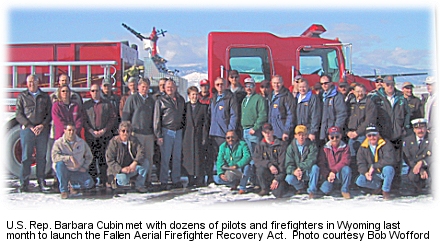 "Common sense tells us that these firefighters fight fires on public lands," Cubin says. "They protect America, and we ought to protect them." Cubin has drafted a bill, the Fallen Aerial Firefighter Recovery Act, that would amend the Federal Land Policy and Management Act of 1976 to provide death and disability benefits for aerial firefighters. H.R.977 was referred to the Committee on Resources and the Committees on Agriculture and the Judiciary. On the federal level, there's relatively little money at stake. Even if compensation for fire pilots were made retroactive to the PSOB's 1976 inception, Cubin estimates total payments to families would be about $18 million. But that's less than the $20 million Congress gave last year to the Institute for Software Research in West Virginia, and it's considerably less than the $460 million that was spent for one Amphibious Assault Ship. For most pilots' families, the money is less significant than an acknowledgement by the government that their loved ones were doing a valuable, important job.
|

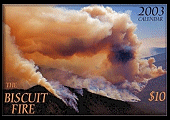


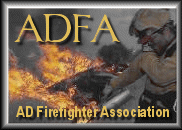


 The new system should reload faster and drop retardant better than the old
The new system should reload faster and drop retardant better than the old 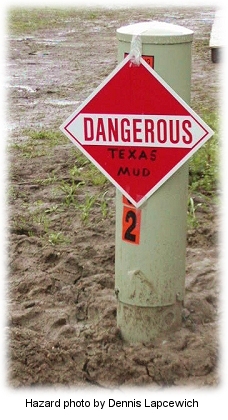 "This is the one we really wanted to get our hands on," said Laura Brown with the
"This is the one we really wanted to get our hands on," said Laura Brown with the  The U.S. intelligence community believes that terrorists will attempt multiple attacks against U.S. and other targets in the event of a military campaign against Saddam Hussein. The DHS and other federal departments have activated increased protective measures under a national plan called "Operation Liberty Shield." It includes measures to increase border security, strengthen transportation protections, enhance infrastructure security, increase public health preparedness, and ensure that all federal response assets can be quickly deployed.
The U.S. intelligence community believes that terrorists will attempt multiple attacks against U.S. and other targets in the event of a military campaign against Saddam Hussein. The DHS and other federal departments have activated increased protective measures under a national plan called "Operation Liberty Shield." It includes measures to increase border security, strengthen transportation protections, enhance infrastructure security, increase public health preparedness, and ensure that all federal response assets can be quickly deployed.
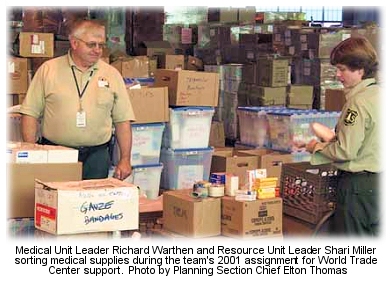 The Severe Condition (Red) reflects a severe risk of terrorist attacks. Protective measures for a red condition are not intended to be sustained for long. In red status, federal agencies would increase or redirect personnel to address critical emergency needs, assign emergency response personnel and pre-position and mobilize specially trained teams or resources, monitor or redirect or constrain transportation systems, or close public and government facilities.
The Severe Condition (Red) reflects a severe risk of terrorist attacks. Protective measures for a red condition are not intended to be sustained for long. In red status, federal agencies would increase or redirect personnel to address critical emergency needs, assign emergency response personnel and pre-position and mobilize specially trained teams or resources, monitor or redirect or constrain transportation systems, or close public and government facilities.
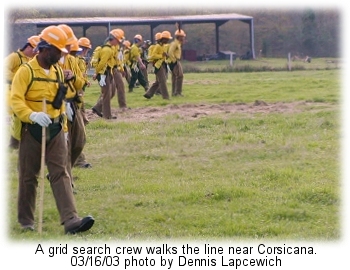 State expenses eligible for reimbursement include search and recovery costs, emergency medical care, security in the affected area, and activation of emergency operations centers. FEMA, a formerly independent agency now a part of the Department of Homeland Security, is in charge of the recovery effort. Since mid-February, more than 3,000 workers per day have searched 103,000 acres, collecting 22,100 pieces of material. As of March 6 the search was using 32 helicopters and nine fixed-wing aircraft; seven boats and underwater sonar units were searching lakes and reservoirs.
State expenses eligible for reimbursement include search and recovery costs, emergency medical care, security in the affected area, and activation of emergency operations centers. FEMA, a formerly independent agency now a part of the Department of Homeland Security, is in charge of the recovery effort. Since mid-February, more than 3,000 workers per day have searched 103,000 acres, collecting 22,100 pieces of material. As of March 6 the search was using 32 helicopters and nine fixed-wing aircraft; seven boats and underwater sonar units were searching lakes and reservoirs.
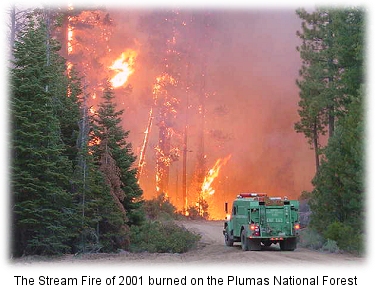 A report by the
A report by the 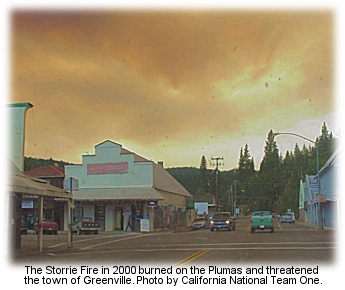
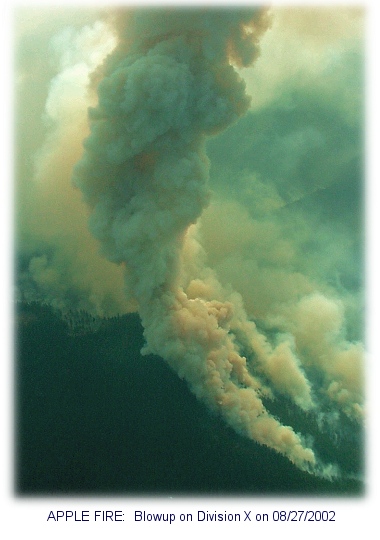 The Forest Service originally considered about 2,500 acres for logging operations. More than half the acreage was removed from consideration, however, after biologists nixed riparian zones and areas with fragile soils. The plan for the "Baked Apple" sale will be submitted to the Federal Register within the next few days, beginning a series of public meetings, release of a draft environmental impact statement, a period for public comment, and printing of a final plan. Harvests are not likely to begin before next year.
The Forest Service originally considered about 2,500 acres for logging operations. More than half the acreage was removed from consideration, however, after biologists nixed riparian zones and areas with fragile soils. The plan for the "Baked Apple" sale will be submitted to the Federal Register within the next few days, beginning a series of public meetings, release of a draft environmental impact statement, a period for public comment, and printing of a final plan. Harvests are not likely to begin before next year.